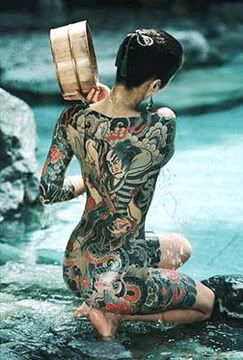
I first came across the Yakuza while looking on National Geographic’s website pictures about different forms on body modification. There was a beautiful picture of a Japanese mistress with her whole back tattooed. The designs were intricate and I wanted to find out more. I have not been able to find out too much, but here is what I have. In researching the Yakuza, I have found that they have been around since 1612 and are the Japanese Mafia. Originally, the tattoo was a black circle around their arm as to signify criminal to outsiders and to punish them socially, but they ended up sticking together and formed a mafia, and with that, their tattoos became more elaborate. Women are not considered members of the Yakuza because they are considered weak and are not born to fight but rather born as mothers who take care of the offspring and their husbands (Sundara 1). According to the Museum of Tattoos “many Yakuza gang factions are patriarchal in nature but women are integral parts of Japan’s gangland society. Wives, mistresses, and girlfriends of top Yakuza figures often undergo extensive tattooing. These women sometimes use tattoos to demonstrate their affiliations with the gang lifestyle. In some cases, it’s done to show loyalty and obedience to the Yakuza member they are involved with” (1). In addition, “the only visible woman in the group is the boss’ wife, called ane-san. Ane-san means “older sister”. All members give her the same respect as the boss because she is his wife. However, she does not yet get involved in the business. Her position in the group is the boss’ wife, and not a member of a group.”(Sundara 1). When researching for this blog, I came across this article titled “Blood Ties: Yakuza daughter lifts lid on hidden hell of gangsters’ families” and it talks about Shoko Tendo, a daughter of a Yakuza boss and she briefly talks about how she did not like what her dad was doing but how she became like him and fell into a terrible lifestyle. What I thought was fascinating was that after she cleaned up and got her life back together, that’s when she got her tattoo, to show past affiliation with the gang. At the end of the article, Shoko says, “I had a hard time as the daughter of a gangster, but looking back I wouldn't have lived my life any other way. I am proud that my father was a yakuza. I know his is a world that has no proper place for women. But I have his DNA.” Having her body tattooed is a constant reminder of her past and being apart of her family’s life style. If you are interested in her story, she has written a book called Yakuza Moon: Memoirs of a Gangster's Daughter. The women of the Yakuza are proud of who they are and their tattooing is an interesting part of their world.
Works Cited
Powles, Gordon. “Yakuza Tattoos”. The museum of tattoos: 22 July 2008
<http://museumoftattoos.com/tattoonews/index.php?option=com_content&task=view&id=187>
McCurry, Justin. “Blood Ties: Yakuza daughter lifts lid on hidden hell of gangsters’ families”. The Guardian 27 June 2007.
<http://www.guardian.co.uk/world/2007/jun/27/books.japan>
Sundara, Miyuki. “ Yakuza, Japanese Mafia”. Organized crime registry
<http://members.tripod.com/orgcrime/japgangint.htm>
Works Cited
Powles, Gordon. “Yakuza Tattoos”. The museum of tattoos: 22 July 2008
<http://museumoftattoos.com/tattoonews/index.php?option=com_content&task=view&id=187>
McCurry, Justin. “Blood Ties: Yakuza daughter lifts lid on hidden hell of gangsters’ families”. The Guardian 27 June 2007.
<http://www.guardian.co.uk/world/2007/jun/27/books.japan>
Sundara, Miyuki. “ Yakuza, Japanese Mafia”. Organized crime registry
<http://members.tripod.com/orgcrime/japgangint.htm>
No comments:
Post a Comment